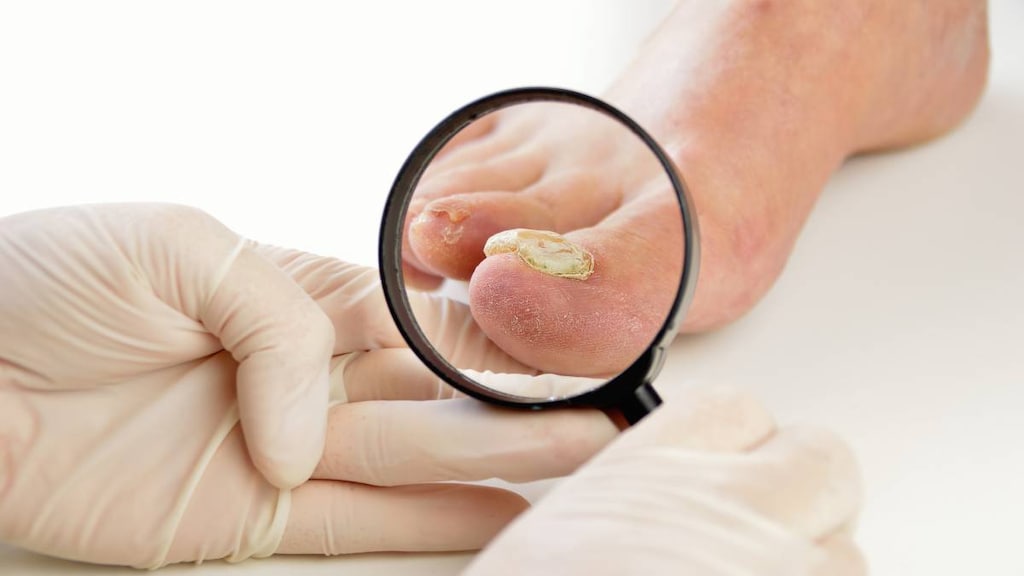What is Stelara?
Stelara is a prescription medicine used to treat:
- adults and children 6 years and older with moderate or severe psoriasis who may benefit from taking injections or pills (systemic therapy) or phototherapy (treatment using ultraviolet light alone or with pills).
- adults 18 years and older with active psoriatic arthritis. Stelara can be used alone or with the medicine methotrexate.
- adults 18 years and older with moderately to severely active Crohn's disease.
- adults 18 years and older with moderately to severely active ulcerative colitis.
It is not known if Stelara is safe and effective in children less than 6 years of age.
What is the most important information I should know about Stelara?
Stelara is a medicine that affects your immune system. Stelara can increase your risk of having serious side effects, including:
- Serious infections. Stelara may lower the ability of your immune system to fight infections and may increase your risk of infections. Some people have serious infections while taking Stelara, including tuberculosis (TB), and infections caused by bacteria, fungi, or viruses. Some people have to be hospitalized for treatment of their infection.
- Your doctor should check you for TB before starting Stelara.
- If your doctor feels that you are at risk for TB, you may be treated with medicine for TB before you begin treatment with Stelara and during treatment with Stelara.
- Your doctor should watch you closely for signs and symptoms of TB while you are being treated with Stelara.
You should not start taking Stelara if you have any kind of infection unless your doctor says it is okay.
Before starting Stelara, tell your doctor if you:- think you have an infection or have symptoms of an infection such as:
- fever, sweat, or chills
- muscle aches
- cough
- shortness of breath
- blood in phlegm
- weight loss
- warm, red, or painful skin or sores on your body
- diarrhea or stomach pain
- burning when you urinate or urinate more often than normal
- feel very tired
- think you have an infection or have symptoms of an infection such as:
- are being treated for an infection or have any open cuts.
- get a lot of infections or have infections that keep coming back.
- have TB, or have been in close contact with someone with TB.
After starting Stelara, call your doctor right away if you have any symptoms of an infection (see above). These may be signs of infections such as chest infections, or skin infections or shingles that could have serious complications. Stelara can make you more likely to get infections or make an infection that you have worse.
People who have a genetic problem where the body does not make any of the proteins interleukin 12 (IL-12) and interleukin 23 (IL-23) are at a higher risk for certain serious infections. These infections can spread throughout the body and cause death. People who take Stelara may also be more likely to get these infections.
- Cancers. Stelara may decrease the activity of your immune system and increase your risk for certain types of cancers. Tell your doctor if you have ever had any type of cancer. Some people who are receiving Stelara and have risk factors for skin cancer have developed certain types of skin cancers. During your treatment with Stelara, tell your doctor if you develop any new skin growths.
- Reversible Posterior Leukoencephalopathy Syndrome (RPLS). RPLS is a rare condition that affects the brain and can cause death. The cause of RPLS is not known. If RPLS is found early and treated, most people recover. Tell your doctor right away if you have any new or worsening medical problems including:
- headache
- seizures
- confusion
- vision problems
Who should not use Stelara?
Do not take Stelara if you are allergic to ustekinumab or any of the ingredients in Stelara. See below for a complete list of ingredients in Stelara.
What should I tell my healthcare provider before using Stelara?
Before you receive Stelara, tell your doctor about all of your medical conditions, including if you:
- have any of the conditions or symptoms listed in the section "What is the most important information I should know about Stelara?"
- ever had an allergic reaction to Stelara. Ask your doctor if you are not sure.
- are allergic to latex. The needle cover on the prefilled syringe contains latex.
- have recently received or are scheduled to receive an immunization (vaccine). People who take Stelara should not receive live vaccines. Tell your doctor if anyone in your house needs a live vaccine. The viruses used in some types of live vaccines can spread to people with a weakened immune system, and can cause serious problems. You should not receive the BCG vaccine during the one year before receiving Stelara or one year after you stop receiving Stelara.
- have any new or changing lesions within psoriasis areas or on normal skin.
- are receiving or have received allergy shots, especially for serious allergic reactions. Allergy shots may not work as well for you during treatment with Stelara. Stelara may also increase your risk of having an allergic reaction to an allergy shot.
- receive or have received phototherapy for your psoriasis.
- are pregnant or plan to become pregnant. It is not known if Stelara can harm your unborn baby. You and your doctor should decide if you will receive Stelara.
- are breastfeeding or plan to breastfeed. It is thought that Stelara passes into your breast milk in small amounts.
- Talk to your doctor about the best way to feed your baby if you receive Stelara.
Tell your doctor about all the medicines you take, including prescription and over-the-counter medicines, vitamins, and herbal supplements.
Know the medicines you take. Keep a list of them to show your doctor and pharmacist when you get a new medicine.
How should I use Stelara?
- Use Stelara exactly as your doctor tells you to.
- The needle cover on the Stelara prefilled syringe contains latex. Do not handle the needle cover if you are sensitive to latex.
- Adults with Crohn's disease and ulcerative colitis will receive the first dose of Stelara through a vein in the arm (intravenous infusion) in a healthcare facility by a healthcare provider. It takes at least 1 hour to receive the full dose of medicine. You will then receive Stelara as an injection under the skin (subcutaneous injection) 8 weeks after the first dose of Stelara, as described below.
- Adults with psoriasis or psoriatic arthritis and children 6 years and older with psoriasis will receive Stelara as an injection under the skin (subcutaneous injection) as described below.
- Injecting Stelara under your skin
- Stelara is intended for use under the guidance and supervision of your doctor. In children 6 years and older, it is recommended that Stelara be administered by a healthcare provider. If your doctor decides that you or a caregiver may give your injections of Stelara at home, you should receive training on the right way to prepare and inject Stelara. Your doctor will determine the right dose of Stelara for you, the amount for each injection, and how often you should receive it. Do not try to inject Stelara yourself until you or your caregiver have been shown how to inject Stelara by your doctor or nurse.
- Inject Stelara under the skin (subcutaneous injection) in your upper arms, buttocks, upper legs (thighs) or stomach area (abdomen).
- Do not give an injection in an area of the skin that is tender, bruised, red or hard.
- Use a different injection site each time you use Stelara.
- If you inject more Stelara than prescribed, call your doctor right away.
- Be sure to keep all of your scheduled follow-up appointments.
Read the detailed Instructions for Use at the end of this Medication Guide for instructions about how to prepare and inject a dose of Stelara, and how to properly throw away (dispose of) used needles and syringes. The syringe, needle and vial must never be re-used. After the rubber stopper is punctured, Stelara can become contaminated by harmful bacteria which could cause an infection if re-used. Therefore, throw away any unused portion of Stelara.
What should I avoid while using Stelara?
You should not receive a live vaccine while taking Stelara. See "What should I tell my healthcare provider before taking Stelara?"
What are the possible side effects of Stelara?
Stelara may cause serious side effects, including:
- See "What is the most important information I should know about Stelara?"
- Serious allergic reactions. Serious allergic reactions can occur with Stelara. Stop using Stelara and get medical help right away if you have any of the following symptoms of a serious allergic reaction:
- feeling faint
- swelling of your face, eyelids, tongue, or throat
- chest tightness
- skin rash
- Lung inflammation. Cases of lung inflammation have happened in some people who receive Stelara, and may be serious. These lung problems may need to be treated in a hospital. Tell your doctor right away if you develop shortness of breath or a cough that doesn't go away during treatment with Stelara.
Common side effects of Stelara include:
- nasal congestion, sore throat, and runny nose
- upper respiratory infections
- fever
- headache
- tiredness
- itching
- nausea and vomiting
- redness at the injection site
- vaginal yeast infections
- urinary tract infections
- sinus infection
- bronchitis
- diarrhea
- stomach pain
These are not all of the possible side effects of Stelara. Call your doctor for medical advice about side effects. You may report side effects to FDA at 1-800-FDA-1088.
You may also report side effects to Janssen Biotech, Inc. at 1-800 JANSSEN (1-800-526-7736).
General information about the safe and effective use of Stelara
Medicines are sometimes prescribed for purposes other than those listed in a Medication Guide. Do not use Stelara for a condition for which it was not prescribed. Do not give Stelara to other people, even if they have the same symptoms that you have. It may harm them. You can ask your doctor or pharmacist for information about Stelara that was written for health professionals.
How should I store Stelara?
- Store Stelara vials and prefilled syringes in a refrigerator between 36°F to 46°F (2°C to 8°C).
- Store Stelara vials standing up straight.
- Store Stelara in the original carton to protect it from light until time to use it.
- Do not freeze Stelara.
- Do not shake Stelara.
If needed, individual Stelara prefilled syringes may also be stored at room temperature up to 30°C (86ºF) for a maximum single period of up to 30 days in the original carton to protect from light. Record the date when the prefilled syringe is first removed from the refrigerator on the carton in the space provided. Once a syringe has been stored at room temperature, it should not be returned to the refrigerator. Discard the syringe if not used within 30 days at room temperature storage. Do not use Stelara after the expiration date on the carton or on the prefilled syringe.
Keep Stelara and all medicines out of the reach of children.
What are the ingredients in Stelara?
Active ingredient: ustekinumab
Inactive ingredients: Single-dose prefilled syringe for subcutaneous use contains L-histidine, L-histidine monohydrochloride monohydrate, Polysorbate 80, and sucrose. Single-dose vial for subcutaneous use contains L-histidine, L-histidine hydrochloride monohydrate, Polysorbate 80 and sucrose. Single-dose vial for intravenous infusion contains EDTA disodium salt dihydrate, L-histidine, L-histidine hydrochloride monohydrate, L-methionine, Polysorbate 80, and sucrose.
For more information, go to www.stelarainfo.com or call 1-800-JANSSEN (1-800-526-7736).
Instructions for use for Stelara
Stelara (stel ar' a)
(ustekinumab)
injection, for subcutaneous use
- Instructions for injecting Stelara using a prefilled syringe.
- Instructions for injecting Stelara from a vial.
Instructions for injecting Stelara using a prefilled syringe.
Read this Instructions for Use before you start using Stelara. Your doctor or nurse should show you how to prepare and give your injection of Stelara the right way.
If you cannot give yourself the injection:
- ask your doctor or nurse to help you, or
- ask someone who has been trained by a doctor or nurse to give your injections.
Do not try to inject Stelara yourself until you have been shown how to inject Stelara by your doctor, nurse or health professional.
Important information:
- Before you start, check the carton to make sure that it is the right dose. You will have either 45 mg or 90 mg as prescribed by your doctor.
- If your dose is 45 mg, you will receive one 45 mg prefilled syringe.
- If your dose is 90 mg, you will receive either one 90 mg prefilled syringe or two 45 mg prefilled syringes. If you receive two 45 mg prefilled syringes for a 90 mg dose, you will need to give yourself two injections, one right after the other.
- Children 12 years of age and older with psoriasis who weigh 132 pounds or more may use a prefilled syringe.
- Check the expiration date on the prefilled syringe and carton. If the expiration date has passed, do not use it. If the expiration date has passed call your doctor or pharmacist, or call 1-800-JANSSEN (1-800-526-7736) for help.
- Make sure the syringe is not damaged.
- The needle cover on the prefilled syringe contains latex. Do not handle the needle cover on the Stelara prefilled syringe if you are allergic to latex.
- Check your prefilled syringe for any particles or discoloration. Your prefilled syringe should look clear and colorless to light yellow with few white particles.
- Do not use if it is frozen, discolored, cloudy or has large particles. Get a new prefilled syringe.
- Do not shake the prefilled syringe at any time. Shaking your prefilled syringe may damage your Stelara medicine. If your prefilled syringe has been shaken, do not use it. Get a new prefilled syringe.
- To reduce the risk of accidental needle sticks, each prefilled syringe has a needle guard that is automatically activated to cover the needle after you have given your injection. Do not pull back on the plunger at any time.
Gather the supplies you will need to prepare and to give your injection. (See Figure A)
You will need:
- antiseptic wipes
- cotton balls or gauze pads
- adhesive bandage
- your prescribed dose of Stelara (See Figure B)
- FDA-cleared sharps disposal container. See “Step 4: dispose of the syringe."

To prevent early activation of the needle safety guard, do not touch the needle guard activation clips at any time during use.

Step 1: Prepare the injection.
- Choose a well-lit, clean, flat work surface.
- Wash your hands well with soap and warm water.
- Hold the prefilled syringe with the covered needle pointing upward.
Step 2: Prepare your injection site
- Choose an injection site around your stomach area (abdomen), buttocks, upper legs (thighs). If a caregiver is giving you the injection, the outer area of the upper arms may also be used. (See Figure C)
- Use a different injection site for each injection. Do not give an injection in an area of the skin that is tender, bruised, red or hard.
- Clean the skin with an antiseptic wipe where you plan to give your injection.
- Do not touch this area again before giving the injection. Let your skin dry before injecting.
- Do not fan or blow on the clean area.
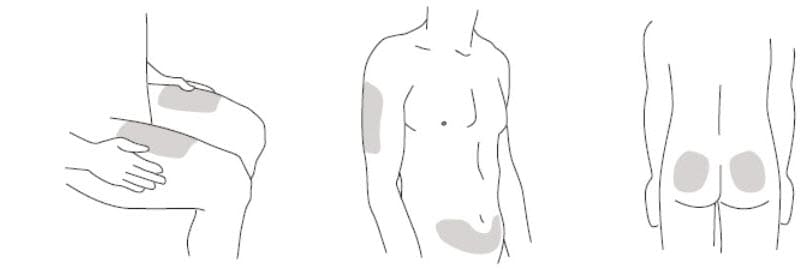
*Areas in gray are recommended injection sites.
Step 3: Inject Stelara
- Remove the needle cover when you are ready to inject your Stelara.
- Do not touch the plunger while removing the needle cover.
- Hold the body of the prefilled syringe with one hand, and pull the needle cover straight off. (see Figure D)
- Put the needle cover in the trash.
- You may also see a drop of liquid at the end of the needle. This is normal.
- Do not touch the needle or let it touch anything.
- Do not use the prefilled syringe if it is dropped without the needle cover in place. Call your doctor, nurse or health professional for instructions.
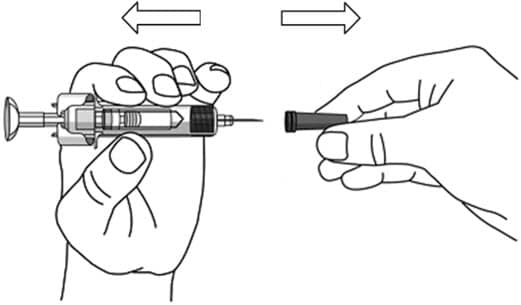
- Hold the body of the prefilled syringe in one hand between the thumb and index fingers. (See Figure E)
Figure E
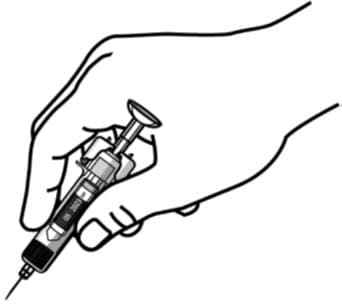
- Do not pull back on the plunger at any time.
- Use the other hand to gently pinch the cleaned area of skin. Hold firmly.
- Use a quick, dart-like motion to insert the needle into the pinched skin at about a 45-degree angle. (See Figure F)
Figure F
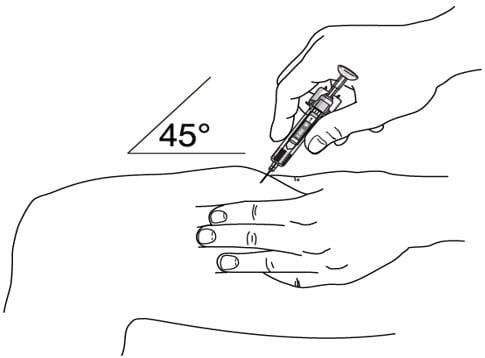
- Inject all of the liquid by using your thumb to push in the plunger until the plunger head is completely between the needle guard wings. (See Figure G)
Figure G
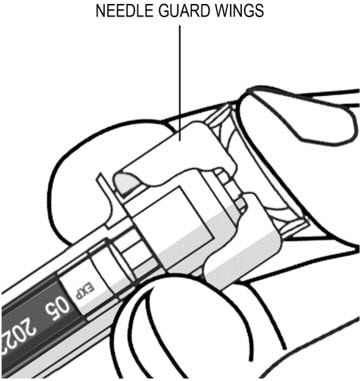
- When the plunger is pushed as far as it will go, keep pressure on the plunger head. Take the needle out of the skin and let go of the skin.
- Slowly take your thumb off the plunger head. This will let the empty syringe move up until the entire needle is covered by the needle guard. (See Figure H)
Figure H
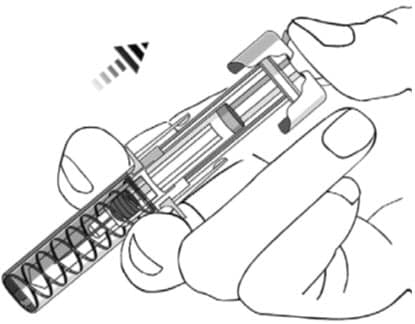
- When the needle is pulled out of your skin, there may be a little bleeding at the injection site. This is normal. You can press a cotton ball or gauze pad to the injection site if needed. Do not rub the injection site. You may cover the injection site with a small adhesive bandage, if necessary.
If your dose is 90 mg, you will receive either one 90 mg prefilled syringe or two 45 mg prefilled syringes. If you receive two 45 mg prefilled syringes for a 90 mg dose, you will need to give yourself a second injection right after the first. Repeat Steps 1–3 for the second injection using a new syringe. Choose a different site for the second injection.
Step 4: Dispose of the syringe.
- Put the syringe in a FDA-cleared sharps disposal container right away after use. Do not throw away (dispose of) loose syringes in your household trash.
- If you do not have a FDA-cleared sharps disposal container, you may use a household container that is:
- made of heavy-duty plastic.
- can be closed with a tight-fitting, puncture-resistant lid, without sharps being able to come out.
- upright and stable during use,
- leak-resistant,
- and properly labeled to warn of hazardous waste inside the container.
- When your sharps disposal container is almost full, you will need to follow your community guidelines for the right way to dispose of your sharps disposal container. There may be local or state laws about how to throw away syringes and needles. For more information about safe sharps disposal, and for specific information about sharps disposal in the state that you live in, go to the FDA's website at: www.fda.gov/safesharpsdisposal.
- Do not dispose of your sharps disposal container in your household trash unless your community guidelines permit this. Do not recycle your sharps disposal container.
- If you have any questions, talk to your doctor or pharmacist.
Keep Stelara and all medicines out of the reach of children.
Instructions for use last revised 03/2020.
Instructions for injecting Stelara from a vial.
Read this Instructions for Use before you start using Stelara. Your doctor or nurse should show you how to prepare, measure your dose, and give your injection of Stelara the right way.
If you cannot give yourself the injection:
- ask your doctor or nurse to help you, or
- ask someone who has been trained by a doctor or nurse to give your injections.
Do not try to inject Stelara yourself until you have been shown how to inject Stelara by your doctor, nurse or health professional.
Important information:
- Before you start, check the carton to make sure that it is the right dose. You will have either 45 mg or 90 mg as prescribed by your doctor.
- If your dose is 45 mg or less you will receive one 45 mg vial.
- If your dose is 90 mg, you will receive two 45 mg vials and you will need to give yourself two injections, one right after the other.
- Children 12 years of age and older weighing less than 132 pounds require a dose lower than 45 mg.
- Check the expiration date on the vial and carton. If the expiration date has passed, do not use it. If the expiration date has passed, call your doctor or pharmacist, or call 1-800-JANSSEN (1-800-526-7736) for help.
- Check the vial for any particles or discoloration. Your vial should look clear and colorless to light yellow with few white particles.
- Do not use if it is frozen, discolored, cloudy or has large particles. Get a new vial.
- Do not shake the vial at any time. Shaking your vial may damage your Stelara medicine. If your vial has been shaken, do not use it. Get a new vial.
- Do not use a Stelara vial more than one time, even if there is medicine left in the vial. After the rubber stopper is punctured, Stelara can become contaminated by harmful bacteria which could cause an infection if re-used. Therefore, throw away any unused Stelara after you give your injection.
- Safely throw away (dispose of) Stelara vials after use.
- Do not re-use syringes or needles. See “Step 6: dispose of needles and syringes."
- To avoid needle-stick injuries, do not recap needles.
Gather the supplies you will need to prepare Stelara and to give your injection. (See Figure A)
You will need:
- a syringe with the needle attached, you will need a prescription from your healthcare provider to get syringes with the needles attached from your pharmacy.
- antiseptic wipes
- cotton balls or gauze pads
- adhesive bandage
- your prescribed dose of Stelara
- FDA-cleared sharps disposal container. See “Step 6: dispose of needles and syringes."

Step 1: Prepare the injection.
- Choose a well-lit, clean, flat work surface.
- Wash your hands well with soap and warm water.
Step 2: Prepare your injection site
- Choose an injection site around your stomach area (abdomen), buttocks, and upper legs (thighs).
- If a caregiver is giving you the injection, the outer area of the upper arms may also be used. (See Figure B)
- Use a different injection site for each injection. Do not give an injection in an area of the skin that is tender, bruised, red or hard.
- Clean the skin with an antiseptic wipe where you plan to give your injection.
- Do not touch this area again before giving the injection. Let your skin dry before injecting.
- Do not fan or blow on the clean area.
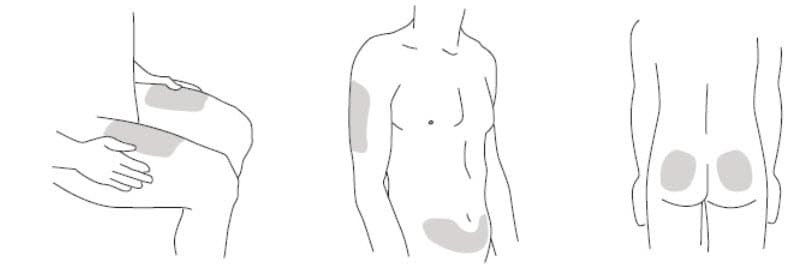
*Areas in gray are recommended injection sites.
Step 3: Prepare the vial.
- Remove the cap from the top of the vial. Throw away the cap but do not remove the rubber stopper. (See Figure C)
Figure C

- Clean the rubber stopper with an antiseptic swab. (See Figure D)
Figure D
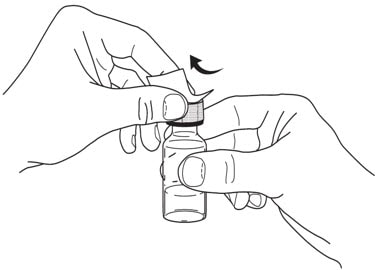
- Do not touch the rubber stopper after you clean it.
- Put the vial on a flat surface.
Step 4: Prepare the needle
- Pick up the syringe with the needle attached.
- Remove the cap that covers the needle. (See Figure E)
- Throw the needle cap away. Do not touch the needle or allow the needle to touch anything.
Figure E
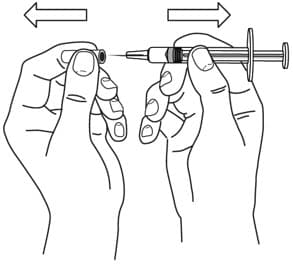
- Carefully pull back on the plunger to the line that matches the dose prescribed by your doctor.
- Hold the vial between your thumb and index (pointer) finger.
- Use your other hand to push the syringe needle through the center of the rubber stopper. (See Figure F)
Figure F
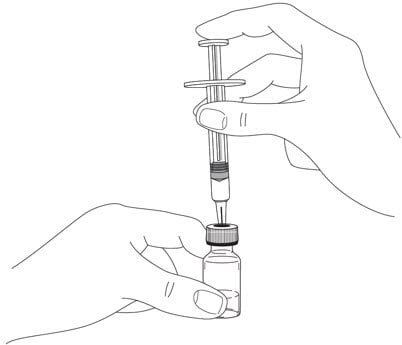
- Push down on the plunger until all of the air has gone from the syringe into the vial.
- Turn the vial and the syringe upside down. (See Figure G)
- Hold the Stelara vial with one hand.
- It is important that the needle is always in the liquid in order to prevent air bubbles forming in the syringe.
- Pull back on the syringe plunger with your other hand.
- Fill the syringe until the black tip of the plunger lines up with the mark that matches your prescribed dose.
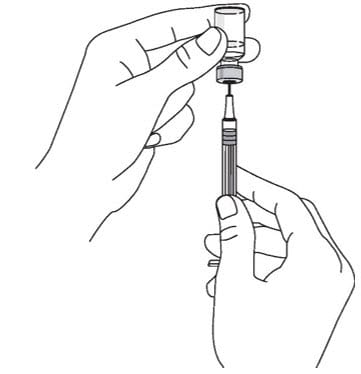
- Do not remove the needle from the vial. Hold the syringe with the needle pointing up to see if it has any air bubbles inside.
- If there are air bubbles, gently tap the side of the syringe until the air bubbles rise to the top. (See Figure H)
- Slowly press the plunger up until all of the air bubbles are out of the syringe (but none of the liquid is out).
- Remove the syringe from the vial. Do not lay the syringe down or allow the needle to touch anything.
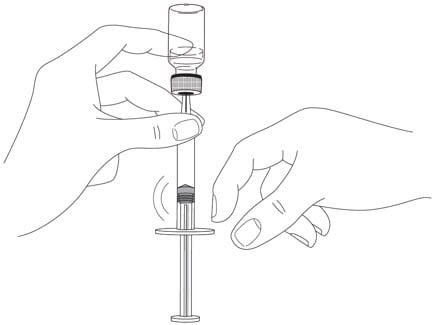
Step 5: Inject Stelara
- Hold the barrel of the syringe in one hand, between the thumb and index fingers.
- Do not pull back on the plunger at any time.
- Use the other hand to gently pinch the cleaned area of skin. Hold firmly.
- Use a quick, dart-like motion to insert the needle into the pinched skin at about a 45-degree angle. (See Figure I)
Figure I
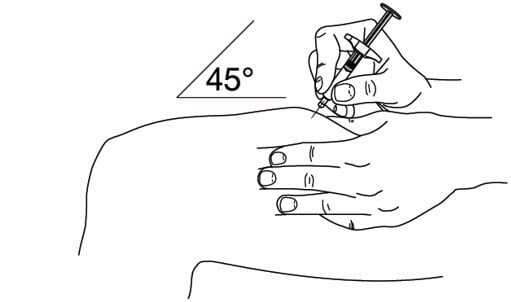
- Push the plunger with your thumb as far as it will go to inject all of the liquid. Push it slowly and evenly, keeping the skin gently pinched.
- When the syringe is empty, pull the needle out of your skin and let go of the skin. (See Figure J)
Figure J
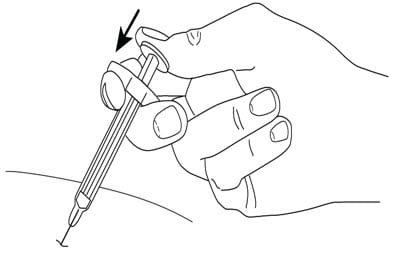
- When the needle is pulled out of your skin, there may be a little bleeding at the injection site. This is normal. You can press a cotton ball or gauze pad to the injection site if needed. Do not rub the injection site. You may cover the injection site with a small adhesive bandage, if necessary.
If your dose is 90 mg, you will receive two 45 mg vials and you will need to give yourself a second injection right after the first. Repeat Steps 1–5 using a new syringe. Choose a different site for the second injection.
Step 6: Dispose of the needles and syringes.
- Do not re-use a syringe or needle.
- To avoid needle-stick injuries, do not recap a needle.
- Put your needles and syringes in a FDA-cleared sharps disposal container right away after use. Do not throw away (dispose of) loose needles and syringes in your household trash.
- If you do not have a FDA-cleared sharps disposal container, you may use a household container that is:
- made of heavy-duty plastic
- can be closed with a tight-fitting, puncture-resistant lid, without sharps being able to come out
- upright and stable during use
- leak-resistant,
- and properly labeled to warn of hazardous waste inside the container.
- When your sharps disposal container is almost full, you will need to follow your community guidelines for the right way to dispose of your sharps disposal container. There may be local or state laws about how to throw away syringes and needles. For more information about safe sharps disposal, and for specific information about sharps disposal in the state that you live in, go to the FDA's website at: www.fda.gov/safesharpsdisposal.
- Do not dispose of your sharps disposal container in your household trash unless your community guidelines permit this. Do not recycle your sharps disposal container.
- Throw away the vial into the container where you put the syringes and needles.
- If you have any questions, talk to your doctor or pharmacist.
Keep Stelara and all medicines out of the reach of children.
Instructions for use last revised 03/2020.


